Research on Wildfires, Soil Erosion and Land Degradation in the XXI Century
Abstract
1. Introduction
1.1. Wildfires
1.2. Soil Erosion and Land Degradation
1.3. Research Proposal
2. Materials and Methods
3. Results and Discussion
3.1. General Information
3.2. Social Structure
3.3. Performance of the Sources
- -
- Catena—70 articles—988 citations;
- -
- Science of the Total Environmental—63 articles—368 citations;
- -
- International Journal of Wildland Fire—41 articles—484 citations;
- -
- Geoderma—38 articles—394 citations;
- -
- Land Degradation and Development—36 articles—351 citations;
- -
- Forest Ecology and Management—35 articles—569 citations;
- -
- Earth Surface Processes and Landforms—31 articles—389 citations;
- -
- Geomorphology—31 articles—509 citations;
- -
- Journal of Environmental Management—27 articles—298 citations;
- -
- Journal of Hydrology—22 articles—434 citations.
3.4. Authors
3.5. Conceptual Structure
4. Discussion
5. Conclusions
Author Contributions
Funding
Institutional Review Board Statement
Informed Consent Statement
Data Availability Statement
Conflicts of Interest
References
- dos Santos, S.M.B.; Bento-Gonçalves, A.; Vieira, A.; Teixeira, G. Large Wildfires in Northwest Portugal: Exploring Spatial Patterns between 2001 and 2020, Based on Landsat Data. Soc. Nat. 2023, 35, e68265. [Google Scholar] [CrossRef]
- Pausas, J.G.; Keeley, J.E. A Burning Story: The Role of Fire in the History of Life. Bioscience 2009, 59, 593–601. [Google Scholar] [CrossRef]
- Pausas, J.G.; Keeley, J.E. Wildfires and Global Change. Front. Ecol. Environ. 2021, 19, 387–395. [Google Scholar] [CrossRef]
- Bento-Gonçalves, A.; Vieira, A.; Úbeda, X.; Martin, D. Fire and Soils: Key Concepts and Recent Advances. Geoderma 2012, 191, 3–13. [Google Scholar] [CrossRef]
- Certini, G. Effects of Fire on Properties of Forest Soils: A Review. Oecologia 2005, 143, 1–10. [Google Scholar] [CrossRef] [PubMed]
- Moody, J.A.; Shakesby, R.A.; Robichaud, P.R.; Cannon, S.H.; Martin, D.A. Current Research Issues Related to Post-Wildfire Runoff and Erosion Processes. Earth-Sci. Rev. 2013, 122, 10–37. [Google Scholar] [CrossRef]
- Vieira, A.; Bento-Gonçalves, A. O Estudo Dos Processos Erosivos Em Áreas Ardidas Em Portugal: Perspetiva Geográfica. In Geografia, Riscos e Proteção Civil. Homenagem ao Professor Doutor Luciano Lourenço; Nunes, A., Amaro, A., Vieira, A., Castro, F., Félix, F., Eds.; Riscos–Associação Portuguesa de Riscos, Prevenção e Segurança: Coimbra, Portugal, 2021; pp. 103–113. [Google Scholar]
- dos Santos, S.M.B.; Bento-Gonçalves, A.; Vieira, A. Research on Wildfires and Remote Sensing in the Last Three Decades: A Bibliometric Analysis. Forests 2021, 12, 604. [Google Scholar] [CrossRef]
- Shakesby, R.; Doerr, S. Wildfire as a Hydrological and Geomorphological Agent. Earth-Sci. Rev. 2006, 74, 269–307. [Google Scholar] [CrossRef]
- Schmidt, M.W.I.; Noack, A.G. Black Carbon in Soils and Sediments: Analysis, Distribution, Implications, and Current Challenges. Global Biogeochem. Cycles 2000, 14, 777–793. [Google Scholar] [CrossRef]
- Shen, S.; Crowley, J.L.; Wang, Y.; Bowring, S.A.; Erwin, D.H.; Sadler, P.M.; Cao, C.; Rothman, D.H.; Henderson, C.M.; Ramezani, J.; et al. Calibrating the End-Permian Mass Extinction. Science 2011, 334, 1367–1372. [Google Scholar] [CrossRef]
- Scott, A. The Pre-Quaternary History of Fire. Palaeogeogr. Palaeoclimatol. Palaeoecol. 2000, 164, 281–329. [Google Scholar] [CrossRef]
- Belcher, C.M.; Collinson, M.E.; Scott, A.C. A 450-Million-Year History of Fire. In Fire Phenomena and the Earth System; Wiley: Hoboken, NJ, USA, 2013; pp. 229–249. [Google Scholar]
- Neary, D.G.; Leonard, J. Wildland Fire: Impacts on Forest, Woodland, and Grassland Ecological Processes. In Wildland Fires: A Worldwide Reality; Bento-Gonçalves, A., Vieira, A., Eds.; Nova Science Publishers: Hauppauge, NY, USA, 2015; pp. 35–112. ISBN 978-1-63483-397-4. [Google Scholar]
- Bowman, D.M.J.S.; Balch, J.; Artaxo, P.; Bond, W.J.; Cochrane, M.A.; D’Antonio, C.M.; DeFries, R.; Johnston, F.H.; Keeley, J.E.; Krawchuk, M.A.; et al. The Human Dimension of Fire Regimes on Earth. J. Biogeogr. 2011, 38, 2223–2236. [Google Scholar] [CrossRef] [PubMed]
- Wittenberg, L. Post-Fire Soil Ecology: Properties and Erosion Dynamics. Isr. J. Ecol. Evol. 2012, 58, 151–164. [Google Scholar] [CrossRef]
- Campo, J.; Andreu, V.; Gimeno-García, E.; González, O.; Rubio, J.L. Occurrence of Soil Erosion after Repeated Experimental Fires in a Mediterranean Environment. Geomorphology 2006, 82, 376–387. [Google Scholar] [CrossRef]
- Neary, D.G. Post-Wildland Fire Desertification: Can Rehabilitation Treatments Make a Difference? Fire Ecol. 2009, 5, 129–144. [Google Scholar] [CrossRef]
- Cerdà, A.; Doerr, S.H. The Effect of Ash and Needle Cover on Surface Runoff and Erosion in the Immediate Post-Fire Period. CATENA 2008, 74, 256–263. [Google Scholar] [CrossRef]
- Doerr, S.H.; Shakesby, R.A.; Blake, W.H.; Chafer, C.J.; Humphreys, G.S.; Wallbrink, P.J. Effects of Differing Wildfire Severities on Soil Wettability and Implications for Hydrological Response. J. Hydrol. 2006, 319, 295–311. [Google Scholar] [CrossRef]
- Neary, D.G.; Gottfried, G.J.; Ffolliott, P.F. Post-Wildfire Watershed Flood Responses. In Proceedings of the Second International Fire Ecology and Fire Management Congress, Orlando, FL, USA, 16–20 November 2003; pp. 16–20. [Google Scholar]
- Cerdà, A. Forest Fires Are not so Bad. A Case Study in Spain. In Soil Conservation and Protection in Europe-The Way Ahead; The SCAPE Advisory Board: Heiloo, The Netherlands, 2006; pp. 59–62. [Google Scholar]
- DeBano, L. The Role of Fire and Soil Heating on Water Repellency in Wildland Environments: A Review. J. Hydrol. 2000, 231–232, 195–206. [Google Scholar] [CrossRef]
- DeBano, L. Water Repellency in Soils: A Historical Overview. J. Hydrol. 2000, 231–232, 4–32. [Google Scholar] [CrossRef]
- Sheridan, G.J.; Lane, P.N.J.; Noske, P.J. Quantification of Hillslope Runoff and Erosion Processes before and after Wildfire in a Wet Eucalyptus Forest. J. Hydrol. 2007, 343, 12–28. [Google Scholar] [CrossRef]
- Terranova, O.; Antronico, L.; Coscarelli, R.; Iaquinta, P. Soil Erosion Risk Scenarios in the Mediterranean Environment Using RUSLE and GIS: An Application Model for Calabria (Southern Italy). Geomorphology 2009, 112, 228–245. [Google Scholar] [CrossRef]
- Prats, S.A.; MacDonald, L.H.; Monteiro, M.; Ferreira, A.J.D.; Coelho, C.O.A.; Keizer, J.J. Effectiveness of Forest Residue Mulching in Reducing Post-Fire Runoff and Erosion in a Pine and a Eucalypt Plantation in North-Central Portugal. Geoderma 2012, 191, 115–124. [Google Scholar] [CrossRef]
- Lourenço, L.; Nunes, A.; Bento-Gonçalves, A.; Vieira, A. Soil Erosion After Wildfires in Portugal: What Happens When Heavy Rainfall Events Occur? In Research on Soil Erosion; Godone, D., Stanchi, S., Eds.; InTech: Rijeka, Croatia, 2012; pp. 65–88. ISBN 978-953-51-0839-9. [Google Scholar]
- Cannon, S.H.; Kirkham, R.M.; Parise, M. Wildfire-Related Debris-Flow Initiation Processes, Storm King Mountain, Colorado. Geomorphology 2001, 39, 171–188. [Google Scholar] [CrossRef]
- Nyman, P.; Sheridan, G.J.; Smith, H.G.; Lane, P.N.J. Evidence of Debris Flow Occurrence after Wildfire in Upland Catchments of South-East Australia. Geomorphology 2011, 125, 383–401. [Google Scholar] [CrossRef]
- C, D.K.; Naqvi, M.W.; Hu, L. A Case Study and Numerical Modeling of Post-Wildfire Debris Flows in Montecito, California. Water 2024, 16, 1285. [Google Scholar] [CrossRef]
- Neary, D.G.; Leonard, J.M. Soil Conservation after Wildfires: Challenges, Failures, and Successes. In Soil Conservation. Strategies, Management and Challenges; Vieira, A., Bento-Gonçalves, A., Eds.; Nova Science Publishers, Inc.: Hauppauge, NY, USA, 2021; pp. 31–66. [Google Scholar]
- Fernandes, P.M.; Davies, G.M.; Ascoli, D.; Fernández, C.; Moreira, F.; Rigolot, E.; Stoof, C.R.; Vega, J.A.; Molina, D. Prescribed Burning in Southern Europe: Developing Fire Management in a Dynamic Landscape. Front. Ecol. Environ. 2013, 11, e4–e14. [Google Scholar] [CrossRef]
- Alencar, A.A.C.; Arruda, V.L.S.; da Silva, W.V.; Conciani, D.E.; Costa, D.P.; Crusco, N.; Duverger, S.G.; Ferreira, N.C.; Franca-Rocha, W.; Hasenack, H.; et al. Long-Term Landsat-Based Monthly Burned Area Dataset for the Brazilian Biomes Using Deep Learning. Remote Sens. 2022, 14, 2510. [Google Scholar] [CrossRef]
- dos Santos, S.M.B.; Duverger, S.G.; Bento-Gonçalves, A.; Franca-Rocha, W.; Vieira, A.; Teixeira, G. Remote Sensing Applications for Mapping Large Wildfires Based on Machine Learning and Time Series in Northwestern Portugal. Fire 2023, 6, 43. [Google Scholar] [CrossRef]
- Cerdà, A.; Lasanta, T. Long-Term Erosional Responses after Fire in the Central Spanish Pyrenees. CATENA 2005, 60, 59–80. [Google Scholar] [CrossRef]
- Mataix-Solera, J.; Cerdà, A.; Arcenegui, V.; Jordán, A.; Zavala, L.M. Fire Effects on Soil Aggregation: A Review. Earth-Sci. Rev. 2011, 109, 44–60. [Google Scholar] [CrossRef]
- Aria, M.; Cuccurullo, C. Bibliometrix: An R-Tool for Comprehensive Science Mapping Analysis. J. Informetr. 2017, 11, 959–975. [Google Scholar] [CrossRef]
- Folharini, S.; Vieira, A.; Bento-Gonçalves, A.; Silva, S.; Marques, T.; Novais, J. Bibliometric Analysis on Wildfires and Protected Areas. Sustainability 2023, 15, 8536. [Google Scholar] [CrossRef]
- Vasconcelos, R.N.; Lima, A.T.C.; Lentini, C.A.D.; Miranda, G.V.; Mendonça, L.F.; Silva, M.A.; Cambuí, E.C.B.; Lopes, J.M.; Porsani, M.J. Oil Spill Detection and Mapping: A 50-Year Bibliometric Analysis. Remote Sens. 2020, 12, 3647. [Google Scholar] [CrossRef]
- Lotka, A.J. The Frequency Distribution of Scientific Productivity. J. Washingt. Acad. Sci. 1926, 16, 317–324. [Google Scholar]
- Chung, K.H.; Cox, R.A.K. Patterns of Productivity in the Finance Literature: A Study of the Bibliometric Distributions. J. Finance 1990, 45, 301. [Google Scholar] [CrossRef]
- Cobo, M.J.; López-Herrera, A.G.; Herrera-Viedma, E.; Herrera, F. An Approach for Detecting, Quantifying, and Visualizing the Evolution of a Research Field: A Practical Application to the Fuzzy Sets Theory Field. J. Informetr. 2011, 5, 146–166. [Google Scholar] [CrossRef]
- Keeley, J.E. Fire Intensity, Fire Severity and Burn Severity: A Brief Review and Suggested Usage. Int. J. Wildl. Fire 2009, 18, 116. [Google Scholar] [CrossRef]
- Poulenard, J.; Podwojewski, P.; Janeau, J.-L.; Collinet, J. Runoff and Soil Erosion under Rainfall Simulation of Andisols from the Ecuadorian Páramo: Effect of Tillage and Burning. CATENA 2001, 45, 185–207. [Google Scholar] [CrossRef]
- Johansen, M.P.; Hakonson, T.E.; Breshears, D.D. Post-fire Runoff and Erosion from Rainfall Simulation: Contrasting Forests with Shrublands and Grasslands. Hydrol. Process. 2001, 15, 2953–2965. [Google Scholar] [CrossRef]
- Wondzell, S.M.; King, J.G. Postfire Erosional Processes in the Pacific Northwest and Rocky Mountain Regions. For. Ecol. Manag. 2003, 178, 75–87. [Google Scholar] [CrossRef]
- Pardini, G.; Gispert, M.; Dunjo, G. Relative Influence of Wildfire on Soil Properties and Erosion Processes in Different Mediterranean Environments in NE Spain. Sci. Total Environ. 2004, 328, 237–246. [Google Scholar] [CrossRef] [PubMed]
- De Dios Benavides-Solorio, J.; Macdonald, L.H. Measurement and Prediction of Post-Fire Erosion at the Hillslope Scale, Colorado Front Range. Int. J. Wildl. Fire 2005, 14, 457. [Google Scholar] [CrossRef]
- Cerdan, O.; Govers, G.; Le Bissonnais, Y.; Van Oost, K.; Poesen, J.; Saby, N.; Gobin, A.; Vacca, A.; Quinton, J.; Auerswald, K.; et al. Rates and Spatial Variations of Soil Erosion in Europe: A Study Based on Erosion Plot Data. Geomorphology 2010, 122, 167–177. [Google Scholar] [CrossRef]
- Kean, J.W.; Staley, D.M.; Cannon, S.H. In Situ Measurements of Post-Fire Debris Flows in Southern California: Comparisons of the Timing and Magnitude of 24 Debris-Flow Events with Rainfall and Soil Moisture Conditions. J. Geophys. Res. 2011, 116, F04019. [Google Scholar] [CrossRef]
- Cerdà, A.; Lucas-Borja, M.E.; Franch-Pardo, I.; Úbeda, X.; Novara, A.; López-Vicente, M.; Popović, Z.; Pulido, M. The Role of Plant Species on Runoff and Soil Erosion in a Mediterranean Shrubland. Sci. Total Environ. 2021, 799, 149218. [Google Scholar] [CrossRef]
- Pierson, F.B.; Carlson, D.H.; Spaeth, K.E. Impacts of Wildfire on Soil Hydrological Properties of Steep Sagebrush-Steppe Rangeland. Int. J. Wildl. Fire 2002, 11, 145. [Google Scholar] [CrossRef]
- Shakesby, R.A.; Coelho, C.O.A.; Ferreira, A.J.D.; Walsh, R.P.D. Ground-level Changes after Wildfire and Ploughing in Eucalyptus and Pine Forests, Portugal: Implications for Soil Microtopographical Development and Soil Longevity. L. Degrad. Dev. 2002, 13, 111–127. [Google Scholar] [CrossRef]
- Ice, G.G.; Neary, D.G.; Adams, P.W. Effects of Wildfire on Soils and Watershed Processes. J. For. 2004, 102, 16–20. [Google Scholar] [CrossRef]
- Fernández, C.; Vega, J.A.; Jiménez, E.; Fonturbel, T. Effectiveness of Three Post-Fire Treatments at Reducing Soil Erosion in Galicia (NW Spain). Int. J. Wildl. Fire 2011, 20, 104. [Google Scholar] [CrossRef]
- Meyer, V.F.; Redente, E.F.; Barbarick, K.A.; Brobst, R. Biosolids Applications Affect Runoff Water Quality Following Forest Fire. J. Environ. Qual. 2001, 30, 1528–1532. [Google Scholar] [CrossRef]
- Guerrero, C.; Gómez, I.; Moral, R.; Mataix-Solera, J.; Mataix-Beneyto, J.; Hernández, T. Reclamation of a Burned Forest Soil with Municipal Waste Compost: Macronutrient Dynamic and Improved Vegetation Cover Recovery. Bioresour. Technol. 2001, 76, 221–227. [Google Scholar] [CrossRef] [PubMed]
- Prats, S.A.; Martins, M.A.d.S.; Malvar, M.C.; Ben-Hur, M.; Keizer, J.J. Polyacrylamide Application versus Forest Residue Mulching for Reducing Post-Fire Runoff and Soil Erosion. Sci. Total Environ. 2014, 468–469, 464–474. [Google Scholar] [CrossRef]
- Gokturk, A.; Olmez, Z.; Temel, F. Some Native Plants for Erosion Control Efforts in Coruh River Valley, Artvin, Turkey. Pakistan J. Biol. Sci. 2006, 9, 667–673. [Google Scholar] [CrossRef][Green Version]
- Brockway, D.G.; Gatewood, R.G.; Paris, R.B. Restoring Grassland Savannas from Degraded Pinyon-Juniper Woodlands: Effects of Mechanical Overstory Reduction and Slash Treatment Alternatives. J. Environ. Manag. 2002, 64, 179–197. [Google Scholar] [CrossRef]
- Pannkuk, C.D.; Robichaud, P.R. Effectiveness of Needle Cast at Reducing Erosion after Forest Fires. Water Resour. Res. 2003, 39. [Google Scholar] [CrossRef]
- Margiorou, S.; Kastridis, A.; Sapountzis, M. Pre/Post-Fire Soil Erosion and Evaluation of Check-Dams Effectiveness in Mediterranean Suburban Catchments Based on Field Measurements and Modeling. Land 2022, 11, 1705. [Google Scholar] [CrossRef]
- Francos, M.; Vieira, A.; Bento-Gonçalves, A.; Úbeda, X.; Zema, D.A.; Lucas-Borja, M.E. Effects of Wildfire, Torrential Rainfall and Straw Mulching on the Physicochemical Soil Properties in a Mediterranean Forest. Ecol. Eng. 2023, 192, 106987. [Google Scholar] [CrossRef]
- Fernández, C. Tree Mastication and Helimulching: Two Alternatives for Mitigating Soil Erosion and Carbon Loss After Wildfire. For. Sci. 2023, 69, 698–704. [Google Scholar] [CrossRef]
- Fernández, C. Carbon Loss in Sediments and Sequestration in Vegetation after Wildfire and Mulching in a High-Severity Burned Area in NW Spain. J. Sustain. For. 2023, 42, 506–517. [Google Scholar] [CrossRef]
- De la Rosa, J.M.; Jiménez-Morillo, N.T.; González-Pérez, J.A.; Almendros, G.; Vieira, D.; Knicker, H.E.; Keizer, J. Mulching-Induced Preservation of Soil Organic Matter Quality in a Burnt Eucalypt Plantation in Central Portugal. J. Environ. Manag. 2019, 231, 1135–1144. [Google Scholar] [CrossRef]
- Lucas-Borja, M.E.; Zema, D.A.; Fernández, C.; Soria, R.; Miralles, I.; Santana, V.M.; Pérez-Romero, J.; del Campo, A.D.; Delgado-Baquerizo, M. Limited Contribution of Post-Fire Eco-Engineering Techniques to Support Post-Fire Plant Diversity. Sci. Total Environ. 2022, 815, 152894. [Google Scholar] [CrossRef] [PubMed]
- Yıldız, C.; Çömert, R.; Tanyaş, H.; Yılmaz, A.; Akbaş, A.; Akay, S.S.; Yetemen, Ö.; Görüm, T. The Effect of Post-Wildfire Management Practices on Vegetation Recovery: Insights from the Sapadere Fire, Antalya, Türkiye. Front. Earth Sci. 2023, 11, 1174155. [Google Scholar] [CrossRef]
- Fernández, C. Effects of Post-Fire Application of Straw Mulch Strips on Soil Erosion, Soil Moisture and Vegetation Regeneration in European Dry Heathlands in NW Spain. Ecol. Eng. 2023, 196, 107095. [Google Scholar] [CrossRef]
- Bombino, G.; Barbaro, G.; Pérez-Cutillas, P.; D’Agostino, D.; Denisi, P.; Foti, G.; Zimbone, S.M. Use of Logs Downed by Wildfires as Erosion Barriers to Encourage Forest Auto-Regeneration: A Case Study in Calabria, Italy. Water 2023, 15, 2378. [Google Scholar] [CrossRef]
- Miller, J.D.; Nyhan, J.W.; Yool, S.R. Modeling Potential Erosion Due to the Cerro Grande Fire with a GIS-Based Implementation of the Revised Universal Soil Loss Equation. Int. J. Wildl. Fire 2003, 12, 85. [Google Scholar] [CrossRef][Green Version]
- Fernández, S.; Marquínez, J.; Menéndez Duarte, R. A Susceptibility Model for Post Wildfire Soil Erosion in a Temperate Oceanic Mountain Area of Spain. CATENA 2005, 61, 256–272. [Google Scholar] [CrossRef]
- Karamesouti, M.; Petropoulos, G.P.; Papanikolaou, I.D.; Kairis, O.; Kosmas, K. Erosion Rate Predictions from PESERA and RUSLE at a Mediterranean Site before and after a Wildfire: Comparison & Implications. Geoderma 2016, 261, 44–58. [Google Scholar] [CrossRef]
- van Leeuwen, W.J.D.; Casady, G.M.; Neary, D.G.; Bautista, S.; Alloza, J.A.; Carmel, Y.; Wittenberg, L.; Malkinson, D.; Orr, B.J. Monitoring Post-Wildfire Vegetation Response with Remotely Sensed Time-Series Data in Spain, USA and Israel. Int. J. Wildl. Fire 2010, 19, 75. [Google Scholar] [CrossRef]
- Efthimiou, N.; Psomiadis, E.; Panagos, P. Fire Severity and Soil Erosion Susceptibility Mapping Using Multi-Temporal Earth Observation Data: The Case of Mati Fatal Wildfire in Eastern Attica, Greece. CATENA 2020, 187, 104320. [Google Scholar] [CrossRef]
- Tang, W.; Llort, J.; Weis, J.; Perron, M.M.G.; Basart, S.; Li, Z.; Sathyendranath, S.; Jackson, T.; Sanz Rodriguez, E.; Proemse, B.C.; et al. Widespread Phytoplankton Blooms Triggered by 2019–2020 Australian Wildfires. Nature 2021, 597, 370–375. [Google Scholar] [CrossRef]
- Chasmer, L.E.; Hopkinson, C.D.; Petrone, R.M.; Sitar, M. Using Multitemporal and Multispectral Airborne Lidar to Assess Depth of Peat Loss and Correspondence with a New Active Normalized Burn Ratio for Wildfires. Geophys. Res. Lett. 2017, 44, 11851–11859. [Google Scholar] [CrossRef]
- Deligiannakis, G.; Pallikarakis, A.; Papanikolaou, I.; Alexiou, S.; Reicherter, K. Detecting and Monitoring Early Post-Fire Sliding Phenomena Using UAV–SfM Photogrammetry and t-LiDAR-Derived Point Clouds. Fire 2021, 4, 87. [Google Scholar] [CrossRef]
- Alexiou, S.; Efthimiou, N.; Karamesouti, M.; Papanikolaou, I.; Psomiadis, E.; Charizopoulos, N. Measuring Annual Sedimentation through High Accuracy UAV-Photogrammetry Data and Comparison with RUSLE and PESERA Erosion Models. Remote Sens. 2023, 15, 1339. [Google Scholar] [CrossRef]
- Satir, O.; Berberoglu, S.; Donmez, C. Mapping Regional Forest Fire Probability Using Artificial Neural Network Model in a Mediterranean Forest Ecosystem. Geomat. Nat. Hazards Risk 2016, 7, 1645–1658. [Google Scholar] [CrossRef]
- Folharini, S.; Vieira, A.; Bento-Gonçalves, A.; Silva, S.; Marques, T.; Novais, J. Soil Erosion Quantification Using Machine Learning in Sub-Watersheds of Northern Portugal. Hydrology 2022, 10, 7. [Google Scholar] [CrossRef]
- Almendros, G.; González-Vila, F.J. Wildfires, Soil Carbon Balance and Resilient Organic Matter in Mediterranean Ecosystems. A Review. Span. J. Soil Sci. 2014, 2. [Google Scholar] [CrossRef]
- Jordán, A.; Zavala, L.M.; Mataix-Solera, J.; Nava, A.L.; Alanís, N. Effect of Fire Severity on Water Repellency and Aggregate Stability on Mexican Volcanic Soils. CATENA 2011, 84, 136–147. [Google Scholar] [CrossRef]
- Caon, L.; Vallejo, V.R.; Ritsema, C.J.; Geissen, V. Effects of Wildfire on Soil Nutrients in Mediterranean Ecosystems. Earth-Sci. Rev. 2014, 139, 47–58. [Google Scholar] [CrossRef]
- Nyman, P.; Sheridan, G.J.; Smith, H.G.; Lane, P.N.J. Modeling the Effects of Surface Storage, Macropore Flow and Water Repellency on Infiltration after Wildfire. J. Hydrol. 2014, 513, 301–313. [Google Scholar] [CrossRef]
- Granged, A.J.P.; Zavala, L.M.; Jordán, A.; Bárcenas-Moreno, G. Post-Fire Evolution of Soil Properties and Vegetation Cover in a Mediterranean Heathland after Experimental Burning: A 3-Year Study. Geoderma 2011, 164, 85–94. [Google Scholar] [CrossRef]
- Shakesby, R.A.; Bento, C.P.M.; Ferreira, C.S.S.; Ferreira, A.J.D.; Stoof, C.R.; Urbanek, E.; Walsh, R.P.D. Impacts of Prescribed Fire on Soil Loss and Soil Quality: An Assessment Based on an Experimentally-Burned Catchment in Central Portugal. CATENA 2015, 128, 278–293. [Google Scholar] [CrossRef]
- Fonseca, F.; de Figueiredo, T.; Nogueira, C.; Queirós, A. Effect of Prescribed Fire on Soil Properties and Soil Erosion in a Mediterranean Mountain Area. Geoderma 2017, 307, 172–180. [Google Scholar] [CrossRef]
- Méndez-López, M.; Jiménez-Morillo, N.T.; Fonseca, F.; de Figueiredo, T.; Parente-Sendín, A.; Alonso-Vega, F.; Arias-Estévez, M.; Nóvoa-Muñoz, J.C. Mercury Mobilization in Shrubland after a Prescribed Fire in NE Portugal: Insight on Soil Organic Matter Composition and Different Aggregate Size. Sci. Total Environ. 2023, 904, 167532. [Google Scholar] [CrossRef] [PubMed]
- Gouveia, C.; DaCamara, C.C.; Trigo, R.M. Post-Fire Vegetation Recovery in Portugal Based on Spot/Vegetation Data. Nat. Hazards Earth Syst. Sci. 2010, 10, 673–684. [Google Scholar] [CrossRef]
- Woods, S.W.; Balfour, V.N. The Effect of Ash on Runoff and Erosion after a Severe Forest Wildfire, Montana, USA. Int. J. Wildl. Fire 2008, 17, 535. [Google Scholar] [CrossRef]
- Úbeda, X.; Pereira, P.; Outeiro, L.; Martin, D.A. Effects of Fire Temperature on the Physical and Chemical Characteristics of the Ash from Two Plots of Cork Oak (Quercus Suber). L. Degrad. Dev. 2009, 20, 589–608. [Google Scholar] [CrossRef]
- Santín, C.; Doerr, S.H.; Otero, X.L.; Chafer, C.J. Quantity, Composition and Water Contamination Potential of Ash Produced under Different Wildfire Severities. Environ. Res. 2015, 142, 297–308. [Google Scholar] [CrossRef]
- Thomaz, E.L. Interaction between Ash and Soil Microaggregates Reduces Runoff and Soil Loss. Sci. Total Environ. 2018, 625, 1257–1263. [Google Scholar] [CrossRef]
- Keizer, J.J.; Coelho, C.O.A.; Shakesby, R.A.; Domingues, C.S.P.; Malvar, M.C.; Perez, I.M.B.; Matias, M.J.S.; Ferreira, A.J.D. The Role of Soil Water Repellency in Overland Flow Generation in Pine and Eucalypt Forest Stands in Coastal Portugal. Soil Res. 2005, 43, 337. [Google Scholar] [CrossRef]
- Keizer, J.J.; Silva, F.C.; Vieira, D.C.S.; González-Pelayo, O.; Campos, I.; Vieira, A.M.D.; Valente, S.; Prats, S.A. The Effectiveness of Two Contrasting Mulch Application Rates to Reduce Post-Fire Erosion in a Portuguese Eucalypt Plantation. CATENA 2018, 169, 21–30. [Google Scholar] [CrossRef]
- Doerr, S.H.; Shakesby, R.A.; Walsh, R.P.D. Soil Water Repellency: Its Causes, Characteristics and Hydro-Geomorphological Significance. Earth-Sci. Rev. 2000, 51, 33–65. [Google Scholar] [CrossRef]
- Jones, M.W.; Abatzoglou, J.T.; Veraverbeke, S.; Andela, N.; Lasslop, G.; Forkel, M.; Smith, A.J.P.; Burton, C.; Betts, R.A.; van der Werf, G.R.; et al. Global and Regional Trends and Drivers of Fire Under Climate Change. Rev. Geophys. 2022, 60, e2020RG000726. [Google Scholar] [CrossRef]
- Parise, M.; Cannon, S.H. Wildfire Impacts on the Processes That Generate Debris Flows in Burned Watersheds. Nat. Hazards 2012, 61, 217–227. [Google Scholar] [CrossRef]

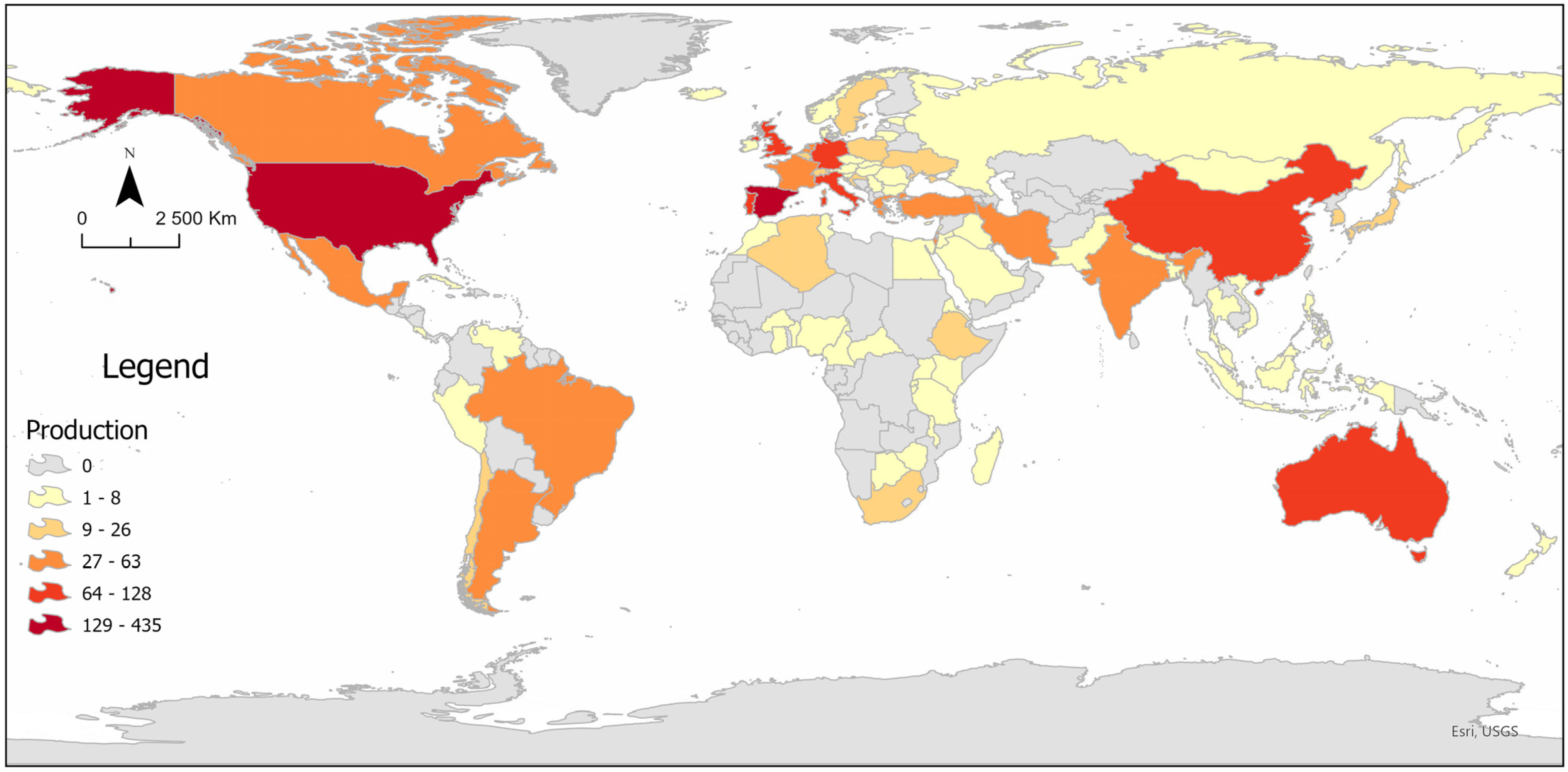
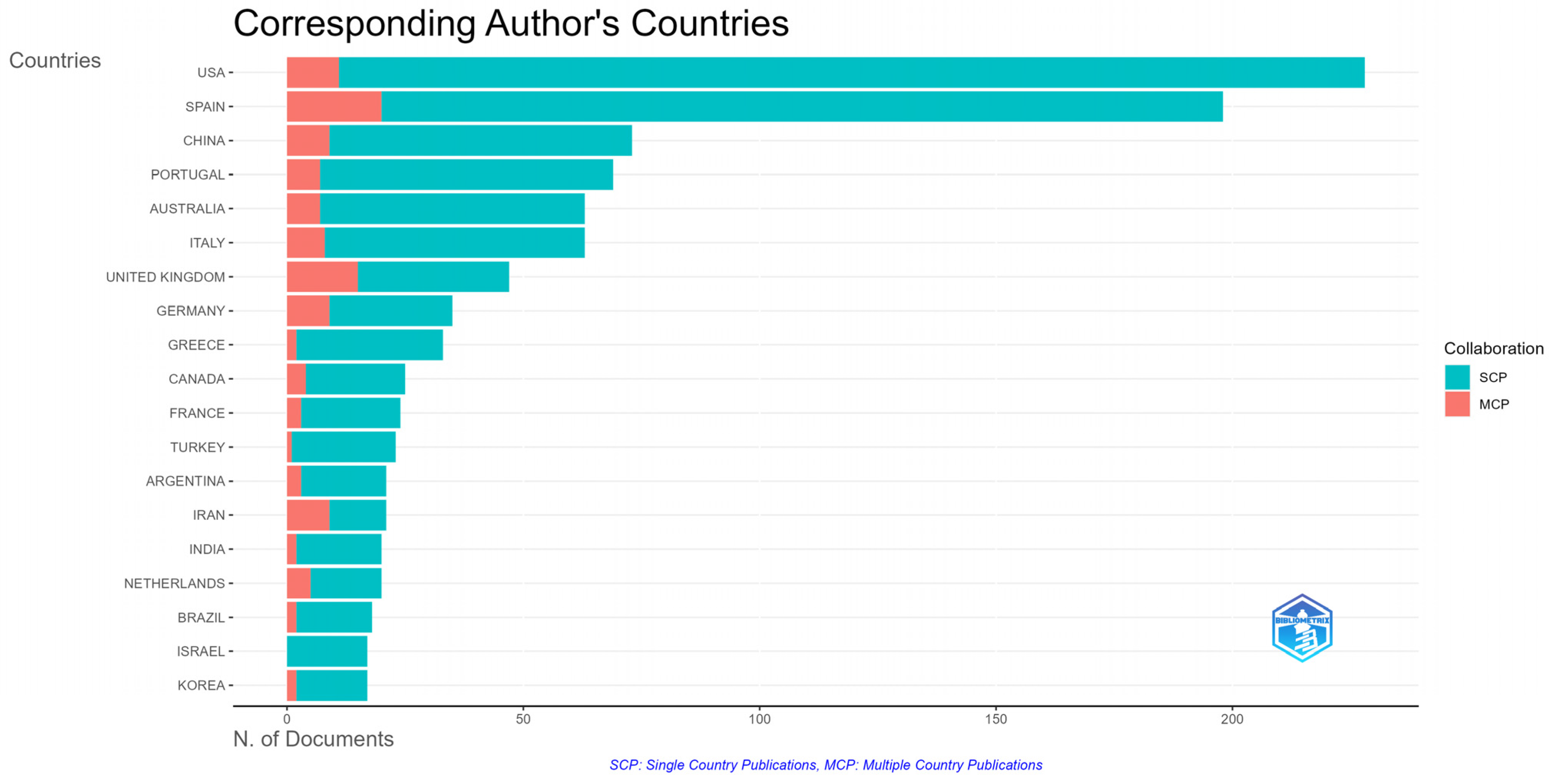
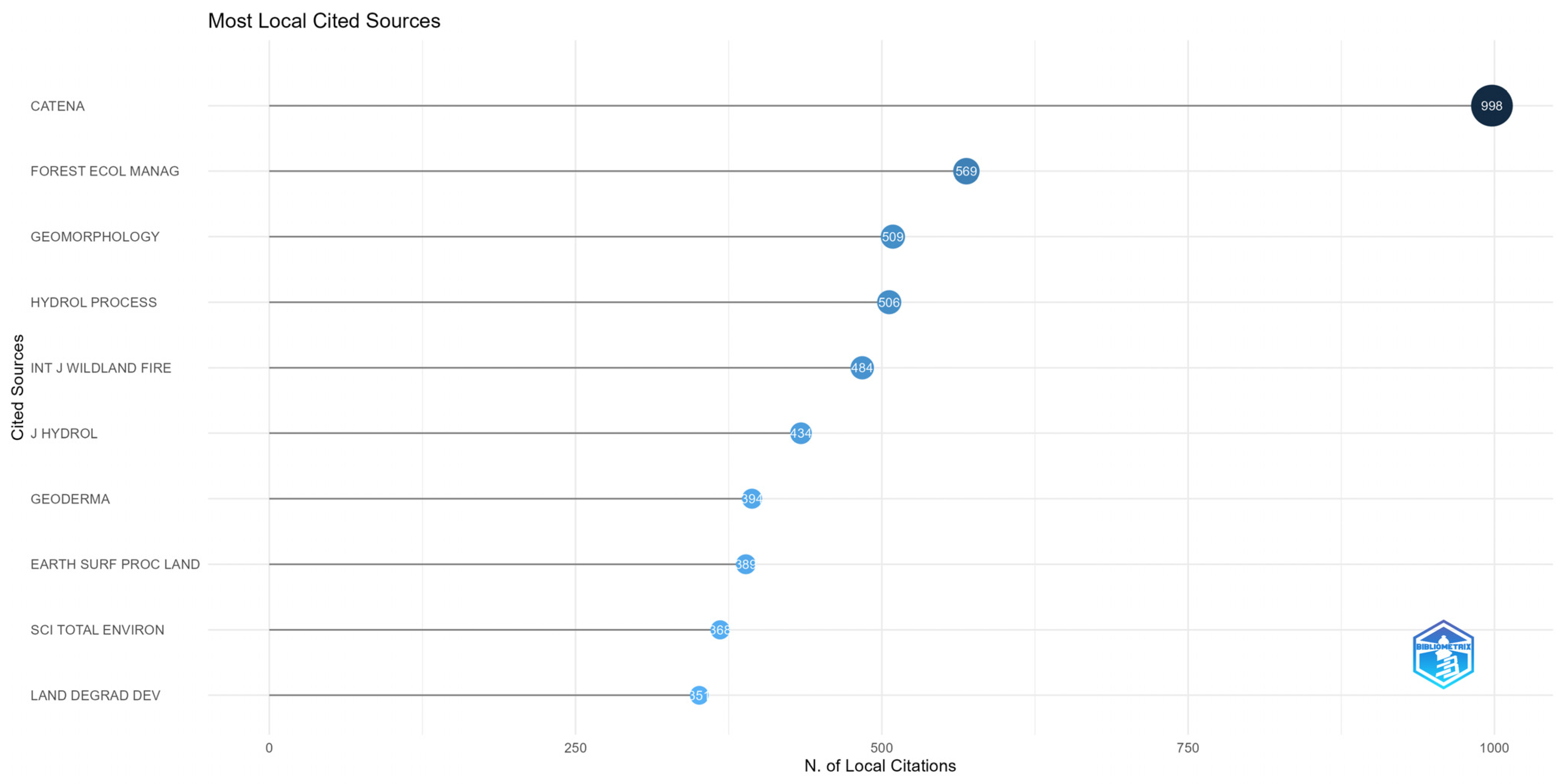
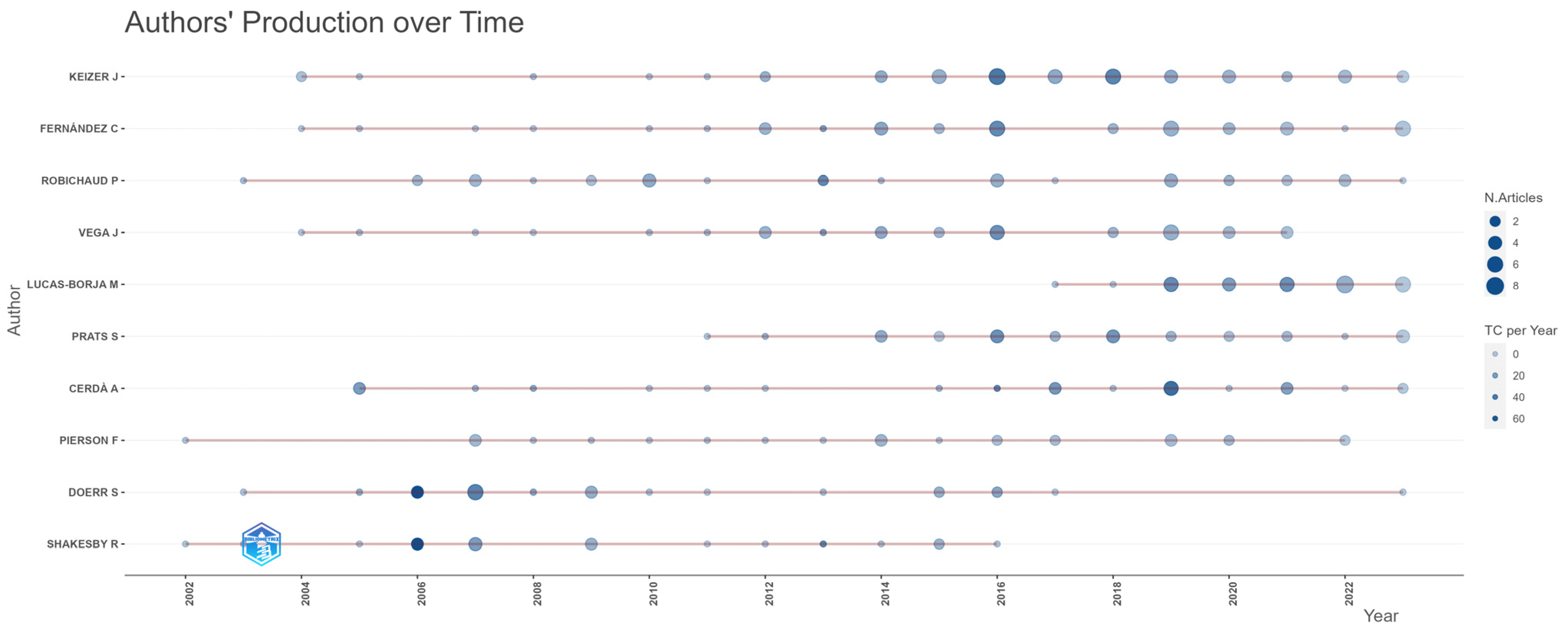
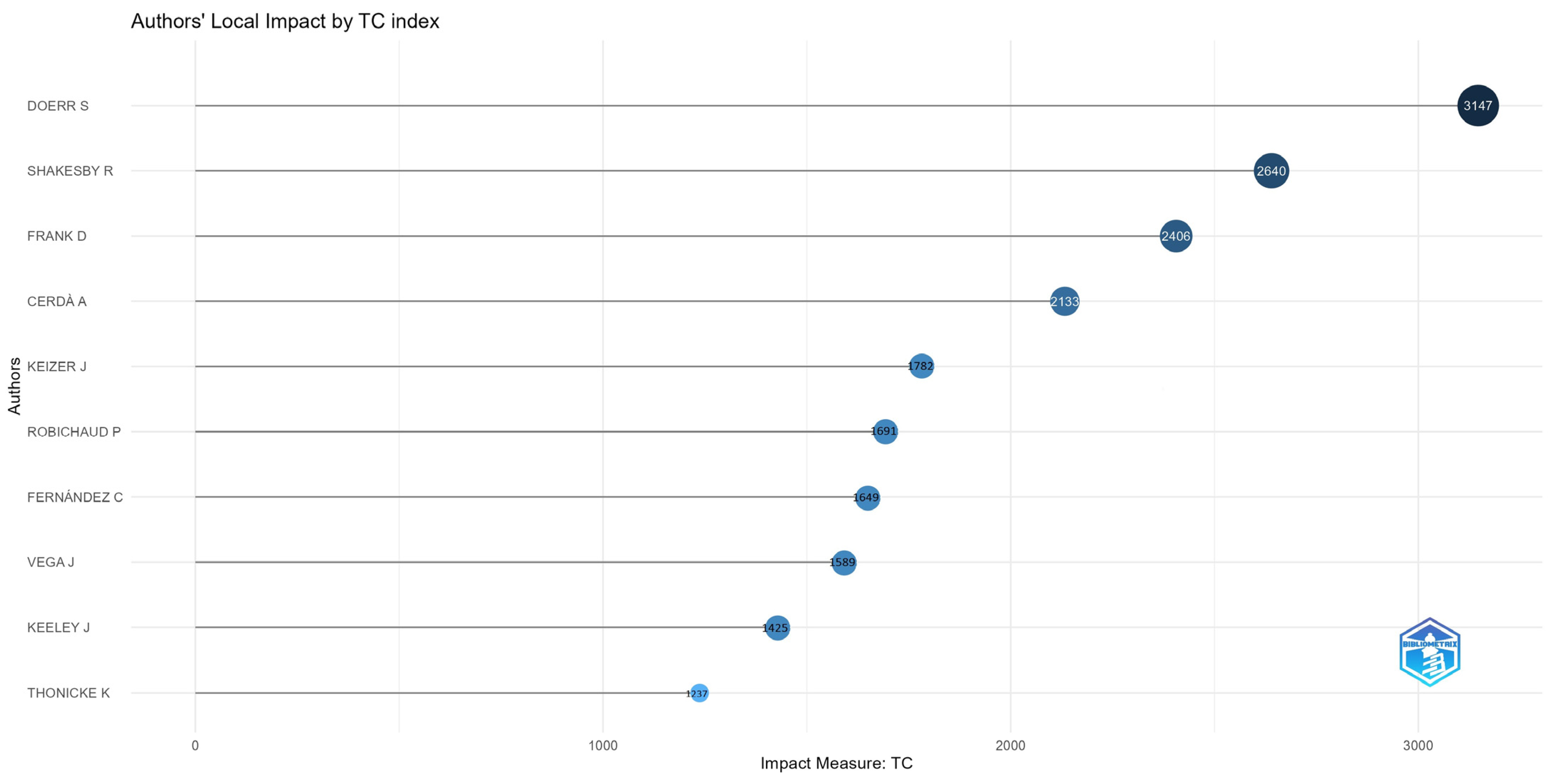

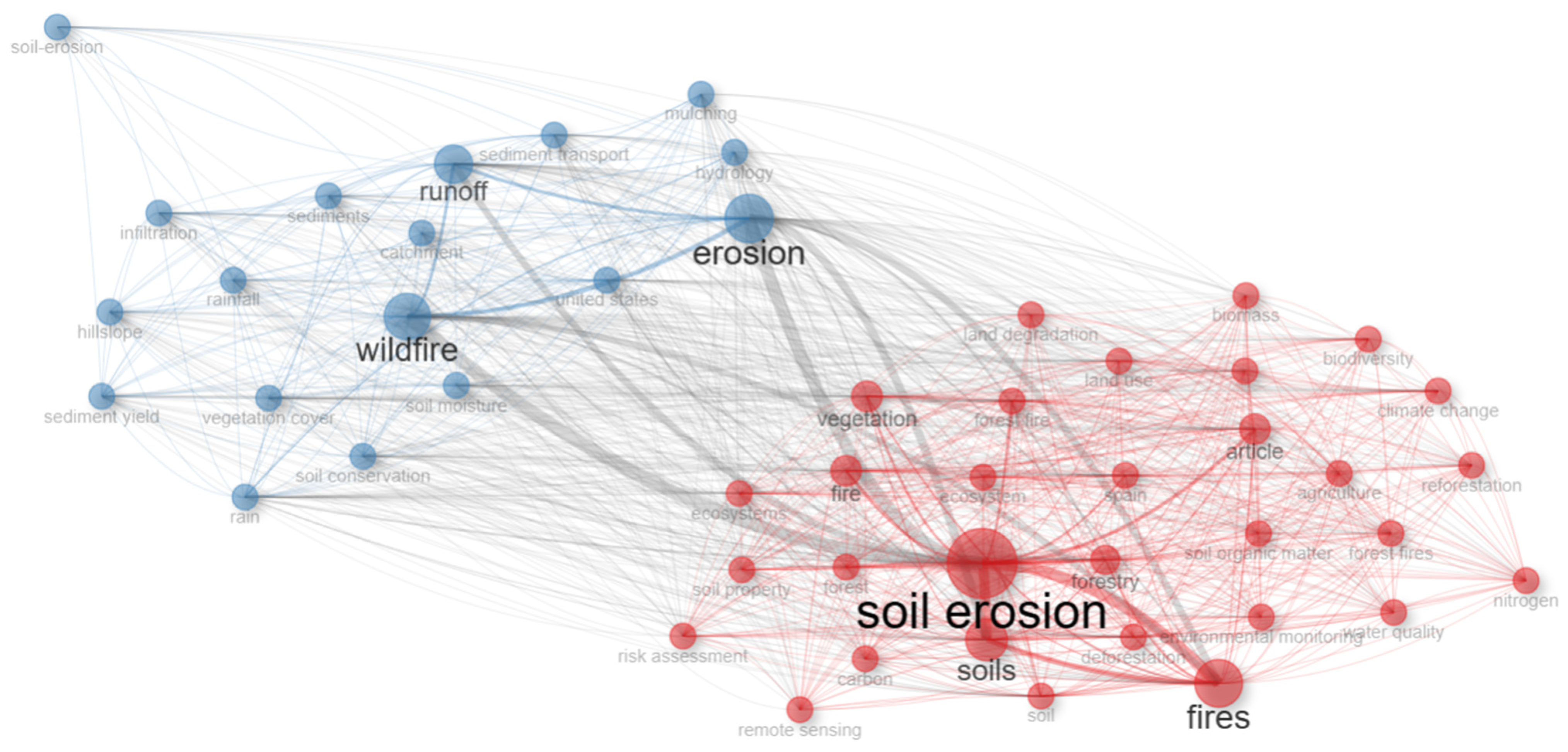

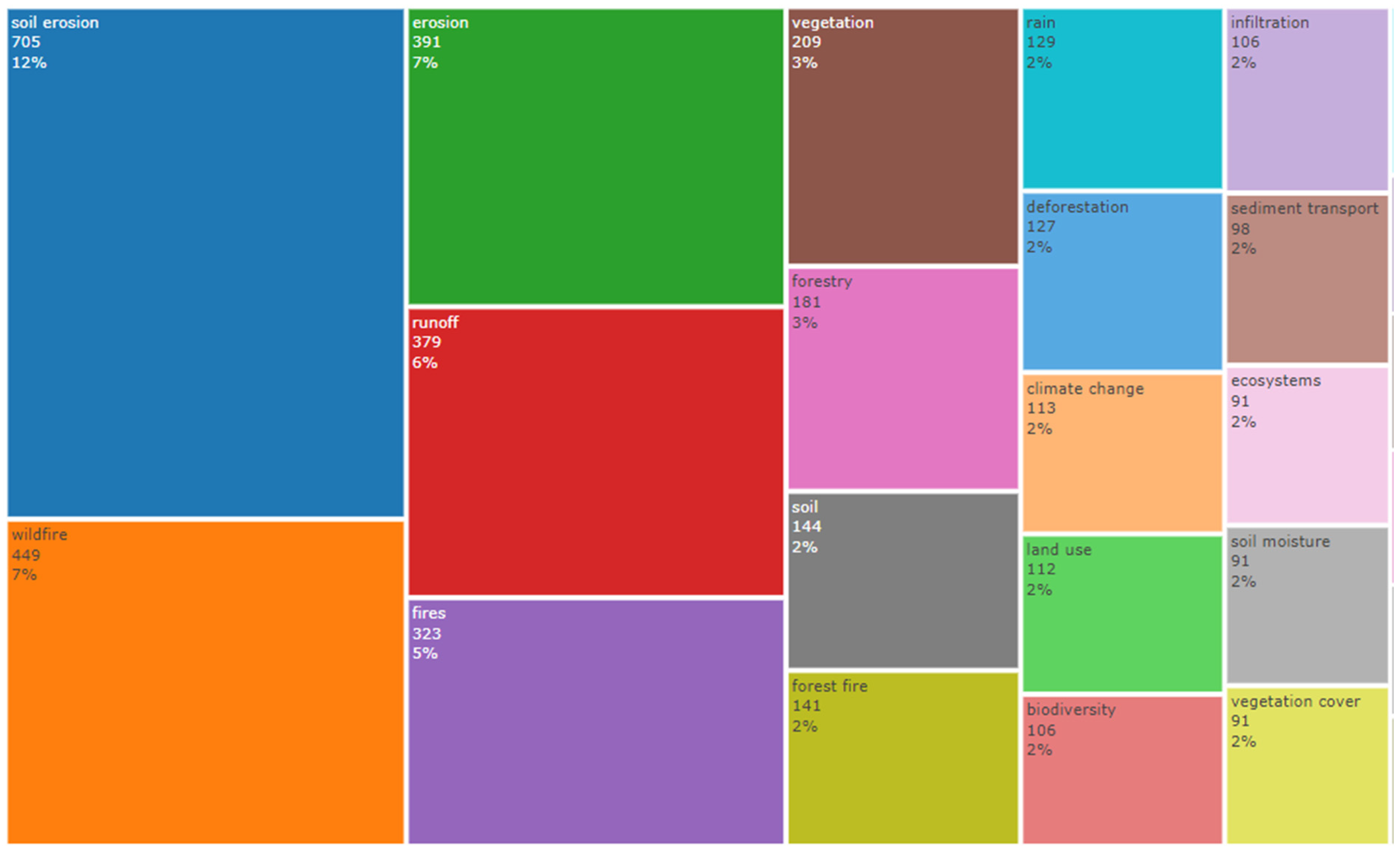
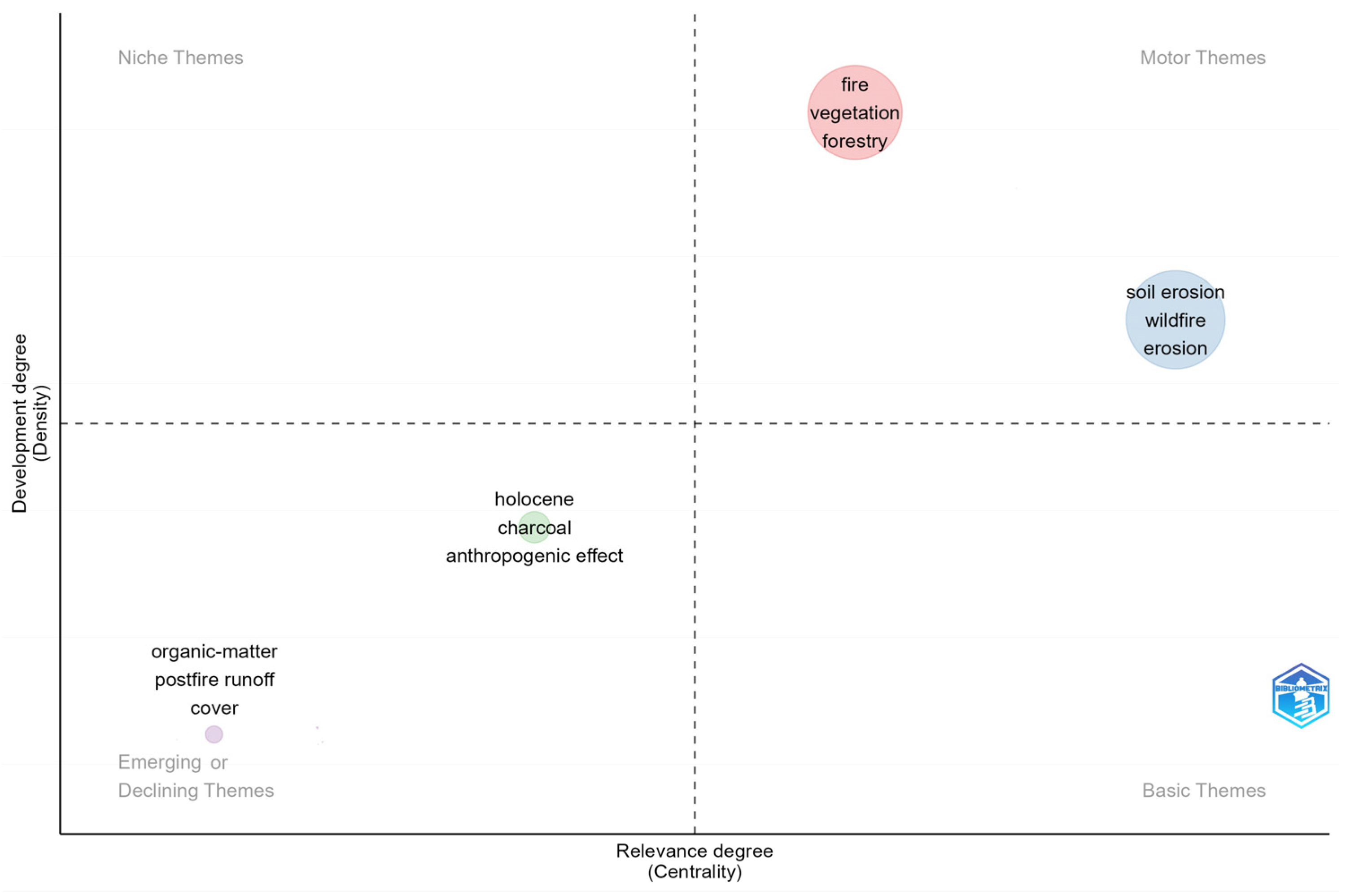
| Description | Results |
|---|---|
| Timespan | 2001–2023 |
| Sources | 457 |
| Articles | 1400 |
| Annual Growth Rate % | 7.85% |
| Average age of articles | 8.97 |
| Average citations per article | 33.29 |
| References | 70,233 |
| ARTICLE CONTENTS | |
| Keywords Plus (ID) | 6783 |
| Author’s keywords (DE) | 3676 |
| AUTHORS | |
| Authors | 4287 |
| Authors of single-authored article | 79 |
| AUTHORS’ COLLABORATION | |
| Single-authored articles | 97 |
| Co-authors per article | 4.71 |
| International co-authorships % | 10.79% |
| Country | TC | Average Article Citations |
|---|---|---|
| USA | 10,283 (31.2%) | 45.10 (10.0%) |
| Spain | 7057 (21.4%) | 35.60 (7.9%) |
| United Kingdom | 2991 (9.1%) | 63.60 (14.0%) |
| Portugal | 2247 (6.8%) | 32.60 (7.2%) |
| Australia | 1965 (6.0%) | 31.20 (6.9%) |
| Germany | 1905 (5.8%) | 54.40 (12.0%) |
| Italy | 1859 (5.6%) | 29.50 (6.5%) |
| China | 1816 (5.5%) | 24.90 (5.5%) |
| Brazil | 1404 (4.3%) | 78.00 (17.2%) |
| France | 1387 (4.2%) | 57.80 (12.8%) |
| Total | 32,914 | 452.7 |
| Affiliation | Articles |
|---|---|
| University of Aveiro (PT) | 154 |
| Colorado State University (USA) | 37 |
| United States Department of Agriculture (USDA) (USA) | 36 |
| Centro de investigación Forestal-Lourizán (SP) | 32 |
| University of California (USA) | 29 |
| University of Haifa (IL) | 29 |
| Aristotle University of Thessaloniki (GR) | 26 |
| Castilla-La mancha University (SP) | 26 |
| University of Arizona (USA) | 26 |
| University of Idaho (USA) | 26 |
| Element | NP | TC | H-Index |
|---|---|---|---|
| Keizer, J. (PT) | 51 | 1782 | 27 |
| Fernández, C. (SP) | 44 | 1649 | 23 |
| Vega, J. (SP) | 34 | 1589 | 23 |
| Robichaud, P. (USA) | 34 | 1691 | 21 |
| Doerr, S. (UK) | 24 | 3147 | 20 |
| Cerdá, A. (SP) | 26 | 2133 | 19 |
| Shakesby, R. (UK) | 20 | 2640 | 19 |
| Pierson, F. (USA) | 25 | 914 | 18 |
| Prats, S. (PT) | 28 | 1060 | 17 |
| Coelho, C. (PT) | 16 | 1118 | 16 |
Disclaimer/Publisher’s Note: The statements, opinions and data contained in all publications are solely those of the individual author(s) and contributor(s) and not of MDPI and/or the editor(s). MDPI and/or the editor(s) disclaim responsibility for any injury to people or property resulting from any ideas, methods, instructions or products referred to in the content. |
© 2024 by the authors. Licensee MDPI, Basel, Switzerland. This article is an open access article distributed under the terms and conditions of the Creative Commons Attribution (CC BY) license (https://creativecommons.org/licenses/by/4.0/).
Share and Cite
Bento-Gonçalves, A.; Vieira, A.; Santos, S.M.d. Research on Wildfires, Soil Erosion and Land Degradation in the XXI Century. Fire 2024, 7, 327. https://doi.org/10.3390/fire7090327
Bento-Gonçalves A, Vieira A, Santos SMd. Research on Wildfires, Soil Erosion and Land Degradation in the XXI Century. Fire. 2024; 7(9):327. https://doi.org/10.3390/fire7090327
Chicago/Turabian StyleBento-Gonçalves, António, António Vieira, and Sarah Moura dos Santos. 2024. "Research on Wildfires, Soil Erosion and Land Degradation in the XXI Century" Fire 7, no. 9: 327. https://doi.org/10.3390/fire7090327
APA StyleBento-Gonçalves, A., Vieira, A., & Santos, S. M. d. (2024). Research on Wildfires, Soil Erosion and Land Degradation in the XXI Century. Fire, 7(9), 327. https://doi.org/10.3390/fire7090327









